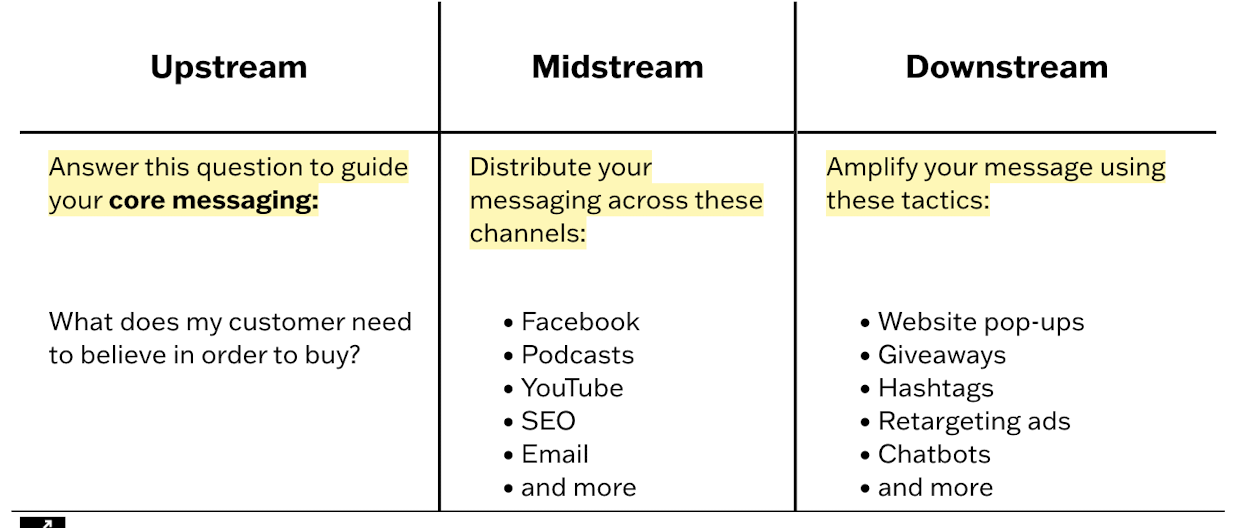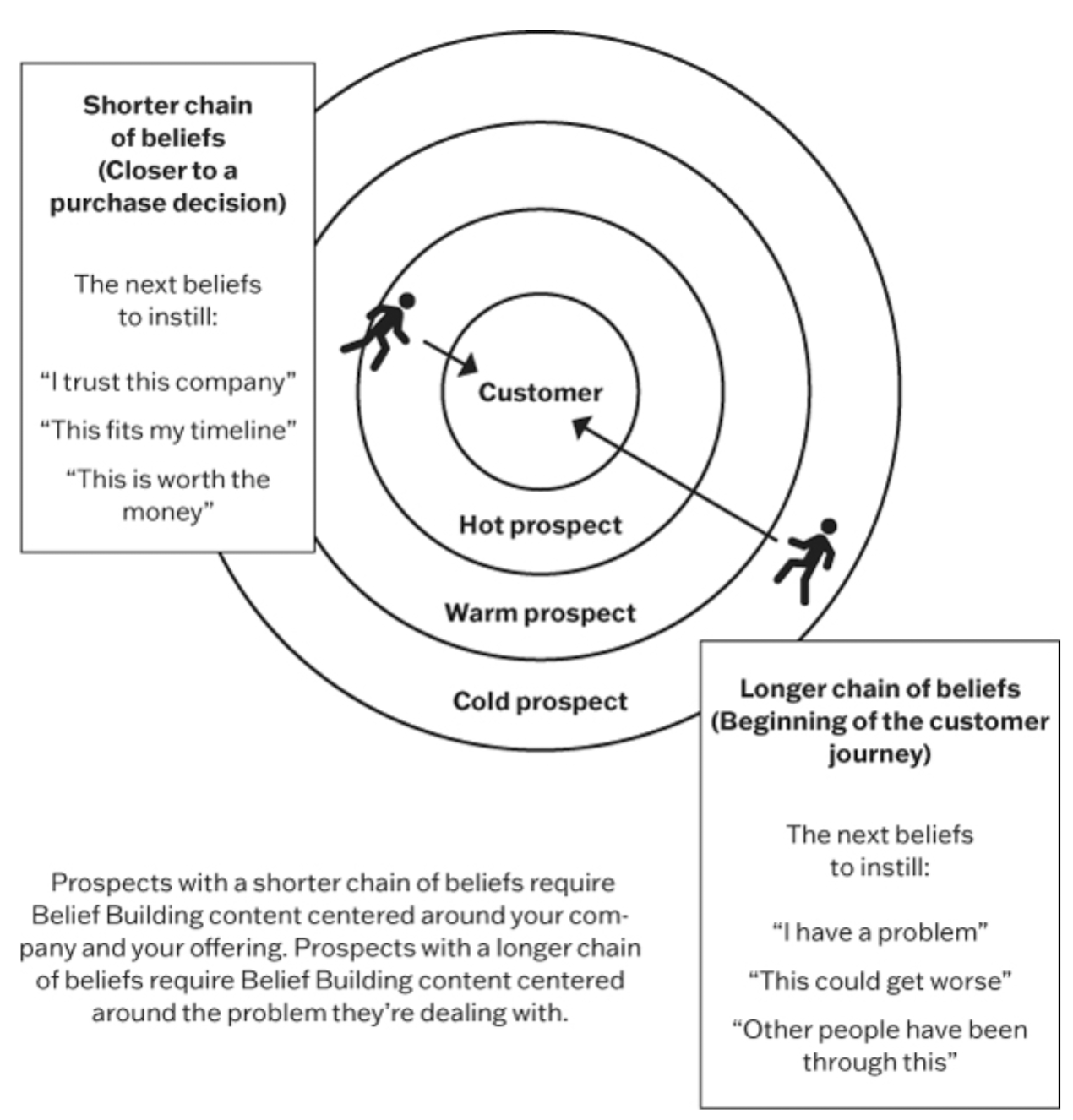Notes from Simple Marketing for Smart People
- Author: Billy Broas, Tiago Forte und Ali Abdaal
- ASIN: B0CW1MQZXP
- 📖 Simple Marketing for Smart People - https://www.amazon.com/dp/B0CW1MQZXP
This core message should clearly articulate why someone should choose your product or service. It acts as the source of a river, from which all marketing activities flow.
Marketing as teaching. You are teaching people how to value your product.
Upstream-Midstream-Downstream
Snapshot from Simple Marketing for Smart People

It is about belief building: What does my prospect need to believe in order to buy? With Belief Building, we establish a shared reality between you and your prospect.
Step-by-step process for Belief Building
Picture the beliefs someone needs to buy from you as a chain. Each belief is linked to (or chained to) another belief.
Chain of Beliefs insights
Snapshot from Simple Marketing for Smart People

Make sure your prospect’s Ladder of Importance matches yours
Ladder or Importance
Snapshot from Simple Marketing for Smart People

Identify the prospect’s current beliefs
Understand what your potential customers already believe about their problems, solutions, and your industry.
- Method 1: Listen for the (Bad) Questions Your Customer Asks
- What do they really want?
- What questions do they ask that aren’t the best questions for achieving that goal?
- How can you redirect them and show them a better path?
- Method 2: Ask Them Questions
- Create a comfortable space for customers to share openly.
- Use “what” and “how” questions instead of “why” questions to avoid judgment and encourage open dialogue.
- Ask open-ended questions that encourage customers to elaborate on their experiences and beliefs.
- Focus on understanding the customer’s goals, motivations, and decision-making processes.
- What led you to purchase X product or hire X service provider?
- Think about the last time this problem occurred. How did you deal with it?
- What makes it important for you to succeed with X?
- Method 3: Peek into the Cycles of Your Prospect’s Life - rituals, routines, or patterns
- Can you walk me through what happened when …
Identify the beliefs required for them to make a purchase
Determine the specific beliefs that would make your product or service the obvious choice for your target audience.
Create marketing content that builds those required beliefs
Use the Customer Journey for Belief Building
Belief Building process with the customer journey, which typically consists of three stages: awareness, consideration, and decision.
Awareness Stage
Customers may not recognize they have a problem. Marketing should educate them about the problem and its consequences.
- What do they need to believe about their problem?
- What do they need to believe about the prevalence (Verbreitung/Größe) of their problem?
- What do they need to believe about what happens if the problem doesn’t get solved? (consequences)
Consideration Stage
Customers are aware of the problem and exploring solutions. Marketing should position the product as a viable and superior solution.
- What do they need to believe about their different options?
- What do they need to believe about my option?
- What do they need to believe about the risks associated with inaction?
Decision Stage
Customers are ready to buy. Marketing should reinforce trust and address any remaining doubts.
- What do they need to believe about me?
- What do they need to believe about my product?
- What do they need to believe about what happens after purchase?
Factors for the Level of Belief building needed
- Price of the product. The lower the price, the less Belief Building you’ll need to do.
- Length of the sales cycle. It takes less time to sell a gallon of milk to a family than accounting software to the government.
- Complexity of the product. A coaching program is more complicated to use than eggs.
- How novel the product is. Henry Ford had to educate horse and buggy owners on his revolutionary Model T car. It took a lot of Belief Building, but it was worth it.
Snapshot from Simple Marketing for Smart People

Ethos-Pathos-Logos for Claim-Proof argumentation
This approach helps build trust, establish an emotional connection, and provide logical reasons for choosing your product or service, ultimately leading to stronger belief in your brand and increased conversions.
Ethos (Credibility):
Ethos refers to the credibility and trustworthiness of the person or brand making the argument. In marketing, establishing ethos is essential for building trust with your audience.
This can be achieved through:
- Expert opinions or endorsements from authoritative figures in the field.
- Testimonials from satisfied customers who have benefited from your product or service.
- Data and research studies that support your claims and demonstrate the effectiveness of your product.
- Third-party reviews and ratings that provide unbiased validation of your offerings.
Pathos (Emotional Appeal)
Pathos appeals to the emotions of the audience, aiming to evoke feelings that resonate with their needs and desires. In marketing, emotional appeals can create a powerful connection with potential customers.
This can be done by:
- Sharing stories that evoke empathy, joy, or other relevant emotions.
- Using imagery and visuals that symbolize deeper sentiments or values.
- Crafting compelling narratives that tap into the aspirations and pain points of your target audience.
Logos (Logical Appeal)
Logos relies on logic and reasoning to persuade the audience. In marketing, logical appeals involve presenting clear and coherent arguments that demonstrate the value and benefits of your product or service.
This can be achieved by:
- Explaining the mechanics of how your product works and how it solves the customer’s problem.
- Providing evidence and data that support your claims about the product’s effectiveness.
- Offering a clear and transparent breakdown of the product’s features, pricing, and value proposition.
Claim-Proof
The book stresses the importance of providing proof to support your marketing claims.
It suggests using various forms of proof:
- including storytelling,
- data, research studies, testimonials, and emotional appeals.
Proof is essential for building trust and credibility with your audience.
Good marketing practice
- Clear and persuasive copywriting.
- Classic, heartfelt storytelling that speaks to people’s everyday problems.
- A strong and well-communicated differentiator, so I stand out from the competition.
- An email list I control and regularly provide value to.
- Informative, insightful content that delivers value upfront while also moving people toward a sale.
- Long-term relationships that will continue to bear fruit for years.
- Authentic testimonials that help people see themselves in what I’m offering.
Action Steps
- Revisit Your Target Audience: Thoroughly understand your target audience, their beliefs, and their needs.
- Complete the Core Messaging Document: Craft a clear and compelling core message that resonates with your audience and addresses their pain points.
- Create New Marketing Material: Develop marketing content that aligns with your core message and effectively builds the required beliefs in your audience.
- Look for More Opportunities to Incorporate Belief Building: Continuously seek ways to integrate Belief Building into your marketing strategies and campaigns.
- Double Down on What Works: Identify the most effective marketing channels and tactics and invest more resources into them.
- Experiment with New Channels and Tactics: Don’t be afraid to try new approaches and test their effectiveness.
Template for assets
Belief: A notebook is a secret weapon of top creatives. Claim: Top thinkers and creatives relied on notebooks throughout history. Proof: Leonardo da Vinci. (ethos) Format: Text + Image. Marketing Channel: Instagram Call-to-Action: Enter your email address for a free PDF
Notes on book structure
- Smart move to provide a bonus and have people immediately register on the mailing list.
- Great idea to have Billy and Tiago in two roles throughout the book
Questions and Observations
Difference Belief and Claim
What is the difference between a belief and a claim?
A belief is an underlying conviction or principle held by a potential customer. These beliefs can be about their problems, the solutions available, or the specific product or service being offered. Beliefs are deeply ingrained and influence a customer’s decision-making process.
A claim, on the other hand, is a statement or assertion made by a marketer about their product or service. In essence, beliefs are the underlying convictions held by customers, while claims are the explicit statements made by marketers to shape and influence those beliefs.
Examples
-
Belief: A potential customer might believe that they are disorganized and need a better system for managing information.
-
Claim: The course creator could claim that their course will teach the customer how to organize their digital life and improve productivity.
-
Belief: A client might believe that having only a will is insufficient for estate planning.
-
Claim: An attorney could claim that a comprehensive estate plan, including trusts and other legal documents, is necessary to protect assets and ensure wishes are carried out.
Linking
- Source: [[Billy Broas-Simple Marketing For Smart People]]
- 📖 Breakthrough Advertising (1966), is considered the Bible of copywriting